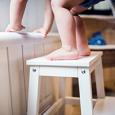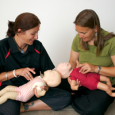Lessons Learned in Child Proofing

When I started to embark on my "Never-ending Adventure of 'Childproofing' a Home", the world of preventable injury was wide and vast and utterly overwhelming. The tips that I learned got me set with a working plan and a path to success. But, what I came to realize is that what I had planned for my then 6-month-old quickly became just the foundation as my crawler became a walker. A whole new world of injury risks and curious hands was ahead of me and here I was, putting the last child lock on the lowest cabinet.
But, in this transition, I started to learn the following vital lessons that have helped me breathe a little easier and work a little smarter.
- Be Attentive. Let's start with a "golden rule" of child safety: supervision is the most important thing you can do. Now, it may be almost impossible to know what your kids are doing at every moment of the day, but knowing what they are doing, and what items to secure/remove, is a big step toward protecting your kids.
- Don't Get Overwhelmed. It is OK to not have everything completely done in the first go around. Though the time between tummy time and crawling and walking moves faster than we realized, doing a few things at a time helps to break the process down into smaller, more manageable areas that we can tackle easily.
- Work with your child. This is not to say we were asking our toddler what risk areas she thought we should look at. But, when it came to protecting our daughter, we did have her interests in mind and looked to create separate play areas in and around our preparations. When we locked all the cabinets in the kitchen, we also created one just for her, unlocked and with items she could play with. Or, when we secured our large cabinet to the wall, but set up buckets and bins to the side and at her eye level so that she had a place to go that was her own. These preventable measures both address the risk area and created a safe space for our daughter to still be a curious little girl. Of course, she tests a boundary here and there, but we know that she has a place where she can play safely in and around the house.
- Keep Up the Good Work. You're not done, and that is OK. When I tell friends or other parents that I work in a child safety non-profit, they almost immediately feel like they have to apologize. "We've been meaning to get another child lock for that cabinet." "Sorry that the we don't have our TV secured yet." "Don't go into the living room; sharp edges everywhere." And to this, I always say, "don't worry about it." We're all doing our best. We live busy lives and we all have the best of intentions. If you think through what your child needs, and are providing them a safe outlet for play and exploration, then you're doing great.
In the end, the biggest thing I've learned is to approach each new childproofing task as chance to revel in my child's development. Every lock I put on, every pot I move away from the edge of the stove means that my little girl is growing more and more into her own person. I am able to spend more time helping her explore because I put the time in to protect her. To me, that is an adventure I hope never ends.
This blog was written by a former employee.




